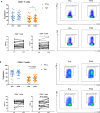Immunomodulatory effects of carbon ion radiotherapy in patients with localized prostate cancer
- PMID: 36138265
- PMCID: PMC10349746
- DOI: 10.1007/s00432-022-04194-9
Immunomodulatory effects of carbon ion radiotherapy in patients with localized prostate cancer
Abstract
Purpose: Radiotherapy is one of the main local treatment modalities for prostate cancer, while immunosuppressive effect induced by radiotherapy is an important factor of radiation resistance and treatment failure. Carbon ion radiotherapy (CIRT) is a novel radiotherapy technique and the immunomodulatory effect of CIRT provides the possibility of overcoming radioresistance and improving efficacy. The aim of this study was to assess the immune response evoked by CIRT in localized prostate cancer patients.
Methods: Thirty-two patients were treated by CIRT combined with or without hormone therapy and peripheral blood samples were collected before and after CIRT. Investigation of peripheral immune cell frequency, proliferation, and cytokine expression was conducted by flow cytometry, real-time quantitative PCR and ELISA.
Results: There were no significant differences in the frequencies of CD3 + , CD4 + , CD8 + T cells and NK cells after CIRT. CD4/CD8 ratio increased whereas B cells decreased. All lymphocyte subsets except regulatory T cells (Tregs) displayed increased proliferation and T cells exhibited increased functionality after CIRT, characterized by modestly increased cytokine secretion of TNF. Moreover, higher frequencies of Tregs were shown. Neither monocytic myeloid-derived suppressor cells (MDSCs) nor early MDSCs changed after CIRT. TGF-β1 gene expression decreased while IL-6 showed a non-significant trend towards a decrease. Both IL-10 gene expression and plasma TGF-β1 level were unchanged.
Conclusion: CIRT demonstrates the potential to elicit immune activation in localized prostate cancer patients, based on sparing lymphocytes, increased lymphocyte proliferation, enhanced T-cell functionality, together with limited induction of immunosuppressive cells and reduced expression of immunosuppressive cytokines.
Keywords: Carbon ion radiotherapy; Immune response; Immunomodulatory effect; Peripheral immune cells; Prostate cancer.
© 2022. The Author(s).
Conflict of interest statement
The authors have no relevant financial or non-financial interests to disclose.
Figures







Similar articles
-
Optimal radiation dose to induce an abscopal effect by combining carbon-ion radiotherapy and anti-CTLA4 antibody.Neoplasia. 2025 Feb;60:101099. doi: 10.1016/j.neo.2024.101099. Epub 2024 Dec 13. Neoplasia. 2025. PMID: 39674115 Free PMC article.
-
Carbon ion irradiation induces DNA damage in melanoma and optimizes the tumor microenvironment based on the cGAS-STING pathway.J Cancer Res Clin Oncol. 2023 Aug;149(9):6315-6328. doi: 10.1007/s00432-023-04577-6. Epub 2023 Feb 6. J Cancer Res Clin Oncol. 2023. PMID: 36745223 Free PMC article.
-
The predictive role of ADC values in prostate cancer patients treated with carbon-ion radiotherapy: initial clinical experience at Shanghai Proton and Heavy Ion Center (SPHIC).J Cancer Res Clin Oncol. 2016 Jun;142(6):1361-7. doi: 10.1007/s00432-016-2142-3. Epub 2016 Mar 23. J Cancer Res Clin Oncol. 2016. PMID: 27008005 Free PMC article.
-
Ganoderma lucidum (Reishi mushroom) for cancer treatment.Cochrane Database Syst Rev. 2012 Jun 13;(6):CD007731. doi: 10.1002/14651858.CD007731.pub2. Cochrane Database Syst Rev. 2012. Update in: Cochrane Database Syst Rev. 2016 Apr 05;4:CD007731. doi: 10.1002/14651858.CD007731.pub3. PMID: 22696372 Updated.
-
Ganoderma lucidum (Reishi mushroom) for cancer treatment.Cochrane Database Syst Rev. 2016 Apr 5;4(4):CD007731. doi: 10.1002/14651858.CD007731.pub3. Cochrane Database Syst Rev. 2016. PMID: 27045603 Free PMC article.
Cited by
-
Clinical application of high-LET radiotherapy combined with immunotherapy in malignant tumors.Precis Radiat Oncol. 2024 Mar 20;8(1):42-46. doi: 10.1002/pro6.1225. eCollection 2024 Mar. Precis Radiat Oncol. 2024. PMID: 40336565 Free PMC article. Review.
-
Changes in lymphocyte subsets pre- and post-particle radiotherapy in head and neck bone and soft tissue tumors.Front Oncol. 2025 Jun 16;15:1543718. doi: 10.3389/fonc.2025.1543718. eCollection 2025. Front Oncol. 2025. PMID: 40657253 Free PMC article.
-
Carbon Ion Radiation Therapy for Nonmetastatic Castration-Resistant Prostate Cancer: A Retrospective Analysis.Adv Radiat Oncol. 2023 Dec 30;9(4):101432. doi: 10.1016/j.adro.2023.101432. eCollection 2024 Apr. Adv Radiat Oncol. 2023. PMID: 38778824 Free PMC article.
-
A future directions of renal cell carcinoma treatment: combination of immune checkpoint inhibition and carbon ion radiotherapy.Front Immunol. 2024 Jul 18;15:1428584. doi: 10.3389/fimmu.2024.1428584. eCollection 2024. Front Immunol. 2024. PMID: 39091498 Free PMC article. Review.
-
Combining theranostic/particle therapy with immunotherapy for the treatment of GU malignancies.BJUI Compass. 2023 Dec 13;5(3):334-344. doi: 10.1002/bco2.316. eCollection 2024 Mar. BJUI Compass. 2023. PMID: 38481668 Free PMC article. Review.
References
-
- Belka C, Ottinger H, Kreuzfelder E, Weinmann M, Lindemann M, Lepple-Wienhues A et al (1999) Impact of localized radiotherapy on blood immune cells counts and function in humans. Radiother Oncol 50:199–204 - PubMed
-
- Bronte V, Zanovello P (2005) Regulation of immune responses by L-arginine metabolism. Nat Rev Immunol 5:641–654 - PubMed
MeSH terms
Substances
LinkOut - more resources
Full Text Sources
Medical
Research Materials

